Major General Raymond Leroy Murray (January 30, 1913 – November 11, 2004 ‘Veterans Day’) was a highly decorated United States Marine Corps officer, who earned a reputation as an exemplary combat leader. Serving first in Shanghai during the Sino-Japanese War in 1937, he later led Marines in several World War II Pacific campaigns. He also participated in the Korean and Vietnam Wars.
He was born in Los Angeles, California. His father was an administrator for the Boy Scouts, and the family moved quite often. From what I have found so far: his father was in Texas in 1910 (National Census), then the family is found in Los Angeles (1913), Phoenix (1920), back to Texas (1920 National Census), and Redondo Beach, California. He spent 1926 and 1927 attending Alhambra High School in California, but he graduated from Harlingen High School in Texas (1930).1 While he was in college, his family moved to Norco, California. In 1935, he earned a bachelor’s degree in English at Texas A&M. As a student, he attended an advanced ROTC program, lettered in football in ’31, ’32 and ’33, was named to the 1933 All-Southwest Conference football team, and was A&M’s Most Valuable Player in 1934. He also played basketball but did not earn a letter.
He briefly accepted a reserve commission in the Army.2 He subsequently resigned the army commission on July 9, 1935, and joined the United States Marine Corps.3 As a newly commissioned Second Lieutenant, he was ordered to the Navy Yard in Philadelphia for Marine Corps Basic School.4
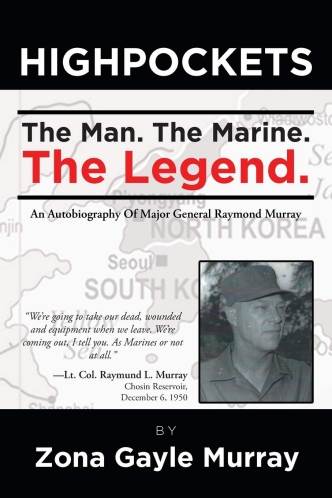
In March 1936, Second Lieutenant Murray joined the 2nd Marine Brigade in San Diego, California. He embarked with the brigade for China in September 1937,and briefly served with the 2nd Battalion in Shanghai. In January 1938, he was assigned to the Marine detachment at the American Embassy in Peking. The embassy was forced to move several times due to the escalating conflict with the Japanese. He was promoted to first lieutenant in August 1938 and to captain in March 1941. In May 1941, Captain Murray sailed for duty in Iceland with the 6th Marines (Reinforced), 1st Provisional Marine Brigade.5
In May 1942, he was promoted to major and in October 1942, Major Murray embarked with the 6th Marines for the Pacific theater. He was cited for conspicuous gallantry on Guadalcanal in January 1943, as commander of the 2nd Battalion, 6th Marines, and was awarded his first Silver Star. He was promoted to lieutenant colonel in June 1943. While commanding the same unit on Tarawa in November 1943, he was awarded a second Silver Star Medal for conspicuous gallantry.6 While still serving in the same capacity on Saipan, he was seriously wounded, but he remained at his post and continued to direct his battalion during the initial assault. He was subsequently awarded the Navy Cross and a Purple Heart for his actions on June 15, 1944.7
Author Leon Uris served as a communications specialist in Murray’s WWII battalion and used his experiences there as the basis for his best-selling 1953 novel “Battle Cry”, which subsequently became a motion picture screenplay. Officer Murray was the model for Uris’ hard-charging Marine battalion commander, Lt. Col. Sam “High Pockets” Huxley. Thus earning Officer Murray the nickname “Highpockets”. (It is generally believed that Uris called him “Highpockets” because at 6′ 3″, Murray’s breast pockets were almost at eye level for most of the men serving in his unit. The average height for a serviceman during World War II was 5’8″.)
Returning to the United States in August 1944, Lieutenant Colonel Murray entered the Command and Staff College at Quantico, Virginia. In 1945, he commanded a composite battalion of enlisted marines, soldiers, sailors and some of the men from the base Basic school, which became the honor guard at President Franklin Roosevelt’s funeral. He received a personal ‘Thank You’ from Eleanor Roosevelt (Apr. 19, 1945). In October 1946, he departed for duty in the Pacific as deputy chief of staff, Headquarters Marine Garrison Forces, Pacific, and the following April was named Inspector of Marine Garrison Forces.
The Korean War started on June 25, 1950, and in July, the 1st Provisional Marine Brigade was formed for duty in Korea. He was ordered overseas with the 5th Marine Regiment, which was to be the nucleus for the brigade. As Commanding Officer, 5th Marines, he was awarded his third and fourth Silver Star Medals and the Legion of Merit during action in August and September 1950. He participated in the battles of the Naktong River perimeter (Pusan Perimeter), Wolmido-Inchon Landing, the retaking of Seoul and Kimpo Air Base; and in the Marine advance north toward the Yalu River. He was subsequently awarded the Army Distinguished Service Cross for extraordinary heroism in the 1st Division’s historic breakout to Hamhung, from the Chosin Reservoir area. His actions in combat earned him his second Navy Cross. In January 1951, with his regiment fighting on the Central Korean front, he was promoted to the rank of colonel, by Major General O.P. Smith. On his return from Korea, he briefly assisted with technical support for the Warner Bros. film, “Retreat Hell”.
On June 19, 1952, he became the commanding officer of the Basic School in Quantico, Virginia. In July 1954, he was ordered to the Marine Corps Base, Camp Pendleton and remained there for four years, serving as commanding officer, 1st Infantry Training Regiment, until February 1955; then as chief of staff of the Marine Corps Base until July 1957. During his final year there, he was assigned to the 1st Marine Division, serving as Division Inspector, chief of staff, and assistant chief of staff, respectively. In July 1958, he assumed duties as chief of staff, Marine Corps Base, Camp Lejeune. He was promoted to brigadier general on June 1, 1959. Later in August 1959, General Murray departed for Okinawa, Japan, and assumed the duties of assistant division commander, 3rd Marine Division. He made a trip to Korea to organize a possible Landing Exercise in the Pohang Area. On April 27, 1960, he received the Korean Order of Military Merit, Ulchi Class with Gold Star in recognition of his efforts some ten years earlier during the Korean War. He also received a “Key to the City” of Seoul (date unknown). In July 1960, he reported to Camp Pendleton, as Deputy Base Commander, and subsequently, in March 1961, became commanding general of the Marine Corps Base, Camp Pendleton. He served in that capacity until June 1962. On July 1, 1962, he began a two-year assignment as commanding general, Marine Corps Recruit Depot, Parris Island. While serving in this capacity, he was promoted to major general on February 1, 1963.
In October 1967, he began his last overseas tour of active duty as deputy commander, III Marine Amphibious Force in South Vietnam. Because of an inner ear infection, which could not be resolved in country, he returned to the United States in February 1968 and entered the U.S. Naval Hospital at Bethesda, Maryland. He remained there until he retired from active duty on August 1, 1968. For the rest of his life, he had recurring problems with balance due to the not completely resolved, inner ear infection.
The general’s medals and decorations includes: the Navy Cross with Gold Star in lieu of a second award; the Army Distinguished Service Cross; the Silver Star Medal with Gold Star and two Oak Leaf Clusters in lieu of second through fourth awards; the Legion of Merit with Combat “V”; the Purple Heart; the Presidential Unit Citation with three bronze stars indicative of second through fourth awards; the China Service Medal; the American Defense Service Medal with the “Base” Bar/Clasp; the European-African-Middle Eastern Campaign Medal; the Asiatic-Pacific Campaign Medal with four bronze stars; the American Campaign Medal; the World War II Victory Medal; the National Defense Service Medal with one bronze star; the Korean Service Medal with four bronze stars; the United Nations Service Medal; the Korean Ulchi Medal with Gold Star; three Korean Presidential Unit Citations; and the Vietnam Service Medal with one star.
After his retirement, he joined the Rotary Club of Oceanside and served as the president in 1975-76.
There is a high school in Vista, California and a bridge in Oceanside, California that are named in his honor. There is a scholarship fund in his name at Texas A&M University for the Corps of Cadets (established April 22, 2022).
Major General Murray gave an oral interview as part of the Marine Corps Oral History Program and received a Certificate of Appreciation from the Commandant of the Marine Corps, General Paul X. Kelley, in June 1986. He died in 2004 and was buried in Oceanside’s Mission San Luis Rey Cemetery. He is best remembered for a quotation he made during the Korean War. Lt. Col. Murray, during the evacuation from the Chosin Reservoir, told his 5th regiment that they would fight as the rearguard out of the mountains. He explained: “We’ll hold our present positions until the Seventh Marines clear the perimeter and are on the road to Koto-ri. Then we’ll come out …and when we come out, we’re bringing our wounded, our dead and our equipment with us…we were ordered up here, and now we’ve been ordered out, and I tell you now, we’re coming out as Marines or not at all…” This is generally reduced to: “We’re going to take our dead, wounded and equipment when we leave. We’re coming out, I tell you, as Marines or not at all.”
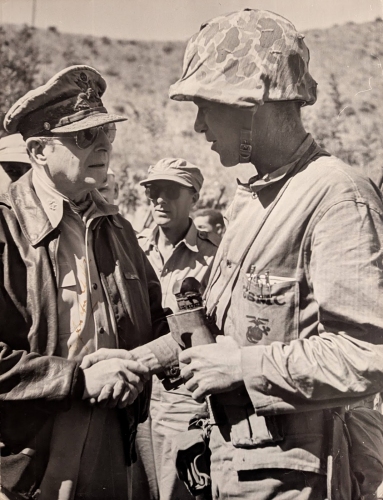
An unpublished picture taken by Carl Mydans for Life Magazine.
September 17, 1950

(It’s 35″ x 45″ and 30+ lbs.)
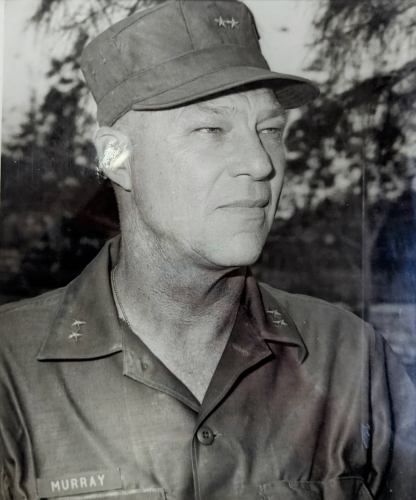
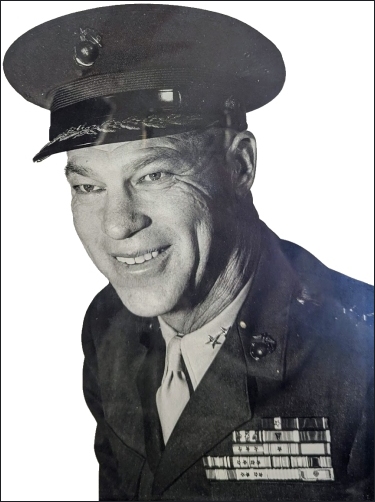
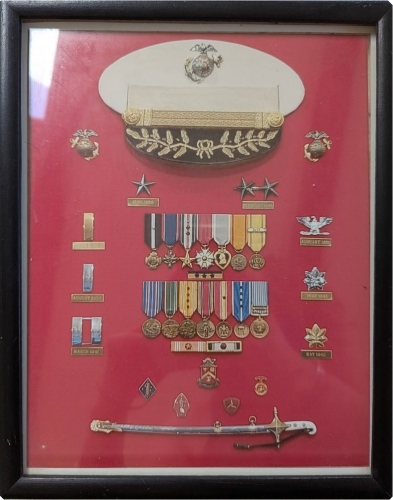

Sept. 17, 1934

Jan. 1, 1951
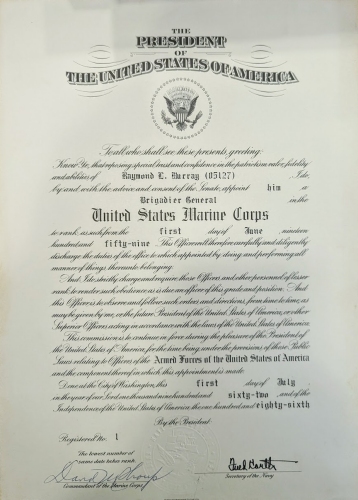
June 1, 1959
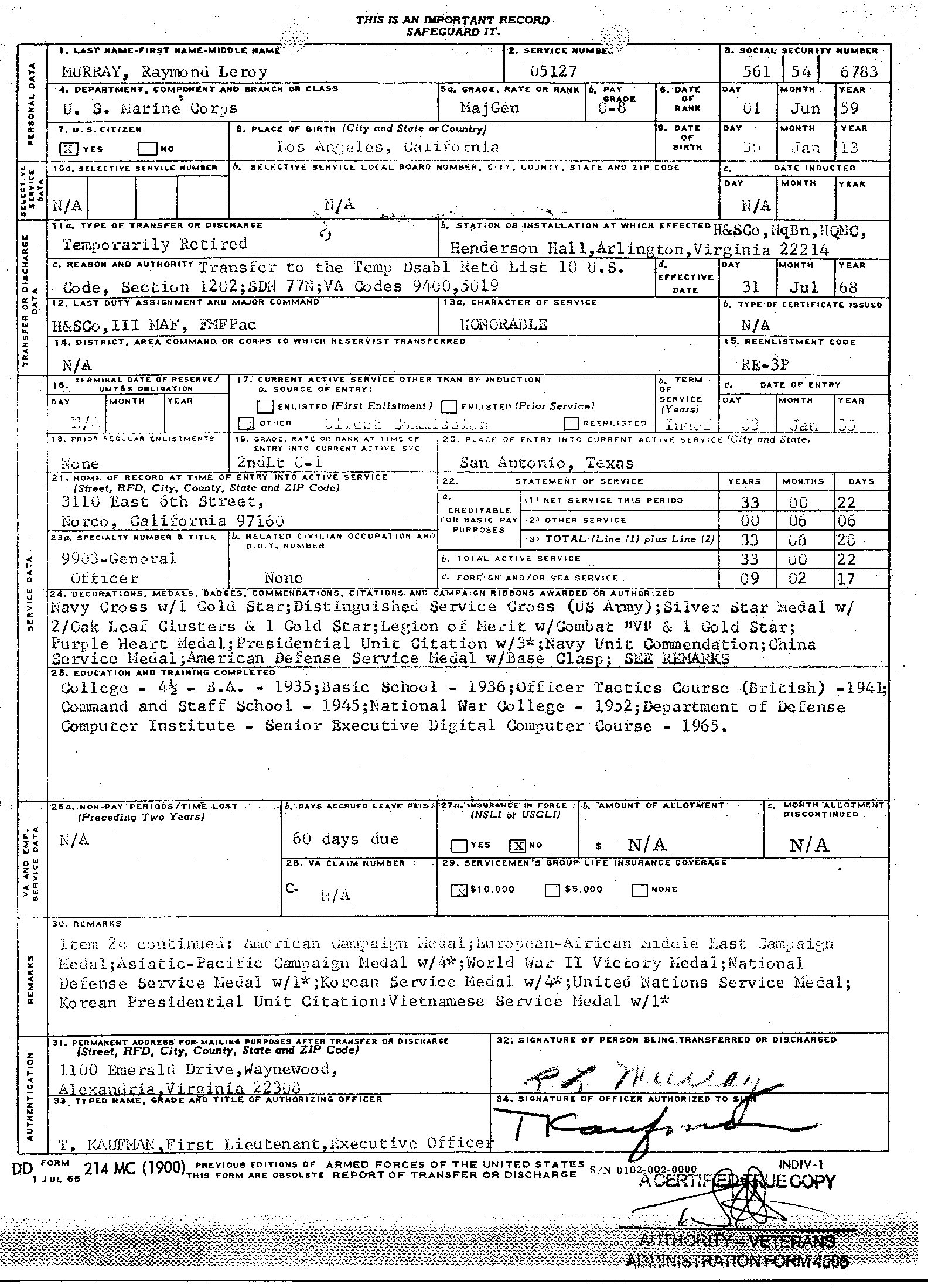

in an early WWII case with blue pillow.
Later cases had yellow / cream pillows.

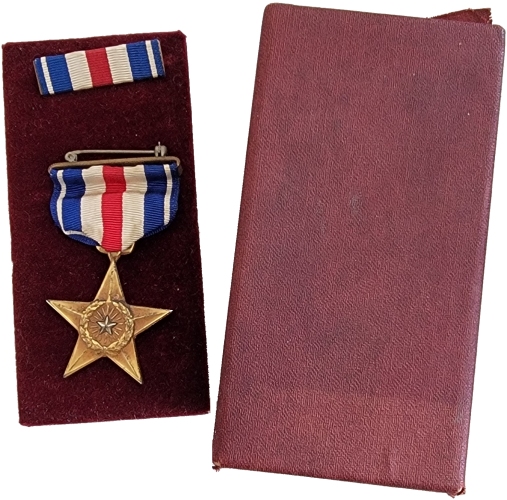
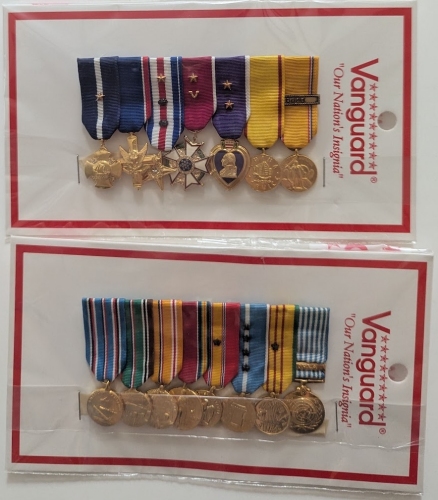
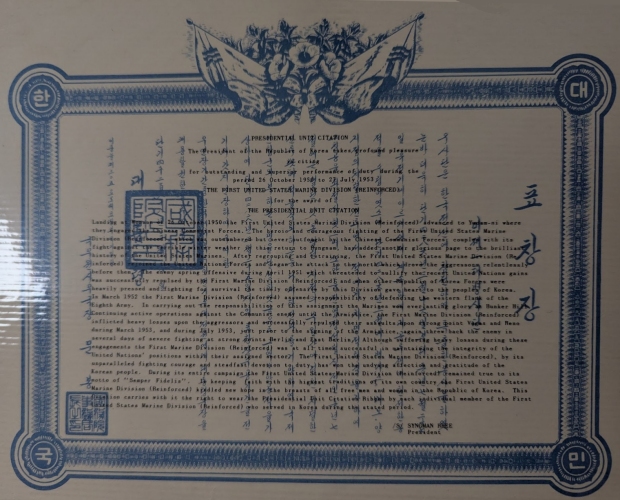
To the 1st United States Marine Division (Reinforced)
For Oct. 26, 1950 to July 27, 1953

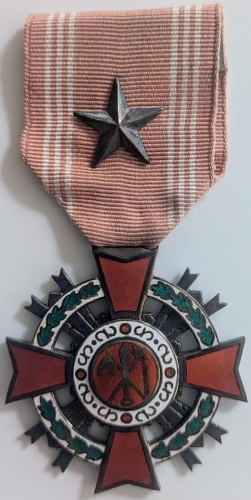

The document references Dec. 15, 1950 but was issued on Apr. 27, 1960. The award was entered on the Korean Medal Roll on 5/7/1960
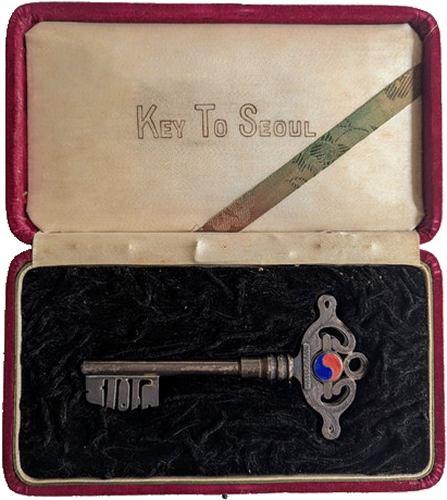
He probably received the Key about the same time that he was awarded the Ulci Medal.
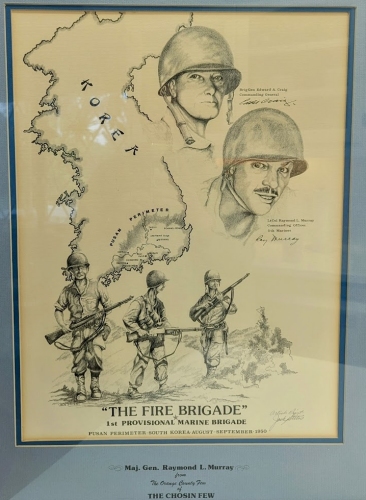
Given to the General by “The Orange County Few of the Chosin Few”
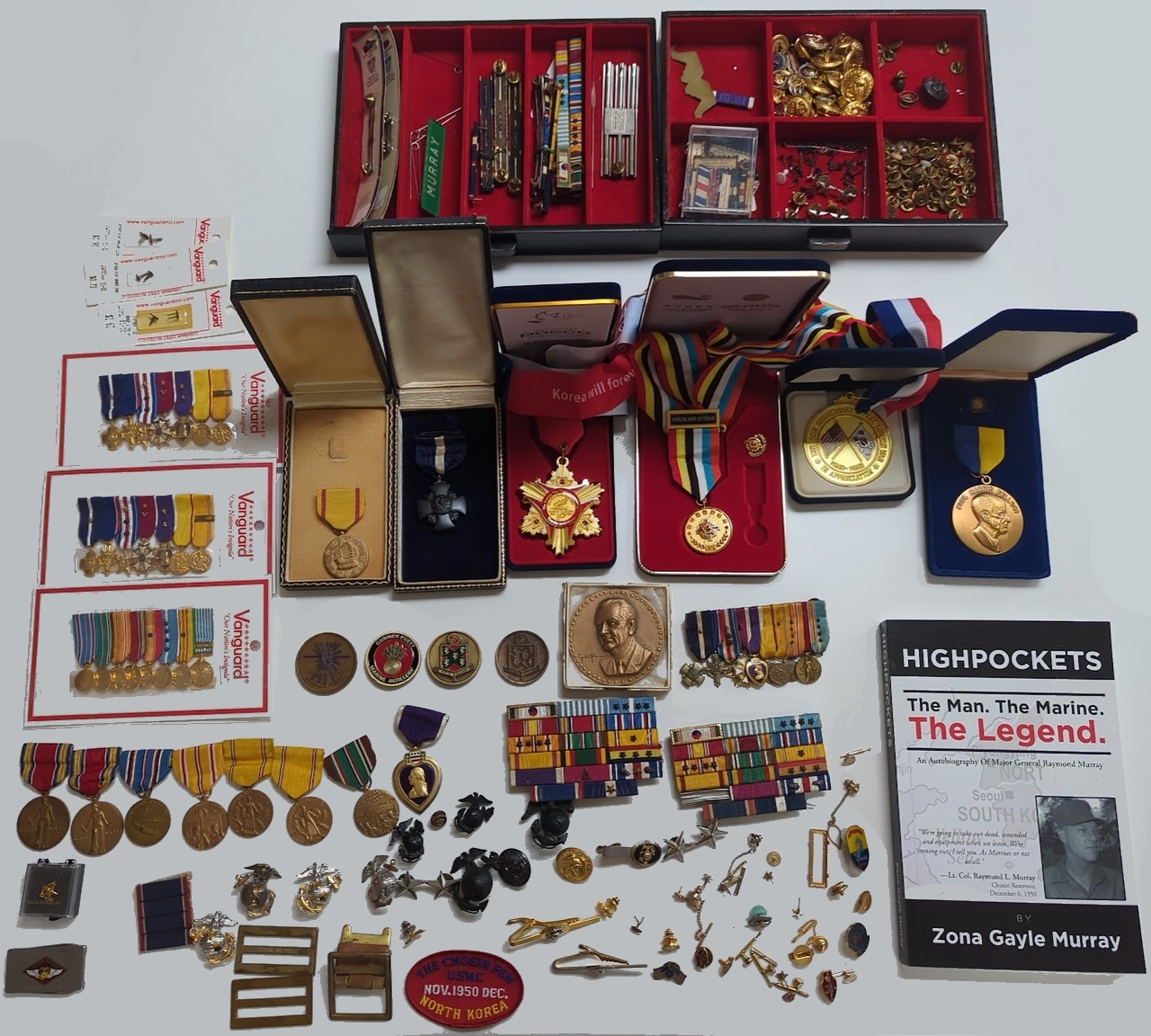

Signed Mar. 29, 1987
Major General Murray was cremated, so it is unknown what happened to his Dress Blue Uniform, his sword and his full-sized medals.8
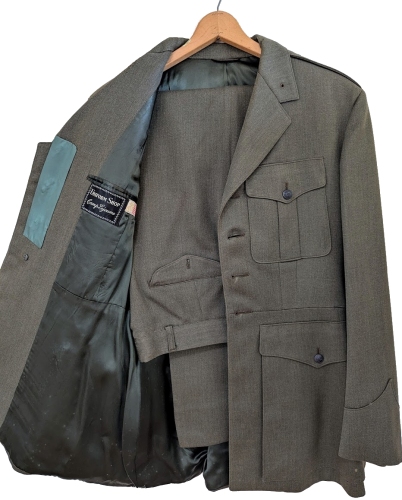
(Business Formal)

“General Grade”

“General Grade”

Lt. Col. Raymond Murray’s instructions for commanding troops at Franklin D. Roosevelt’s Funeral in the Rose Garden at Hyde Park. (Not a part of the collection, found on the internet)
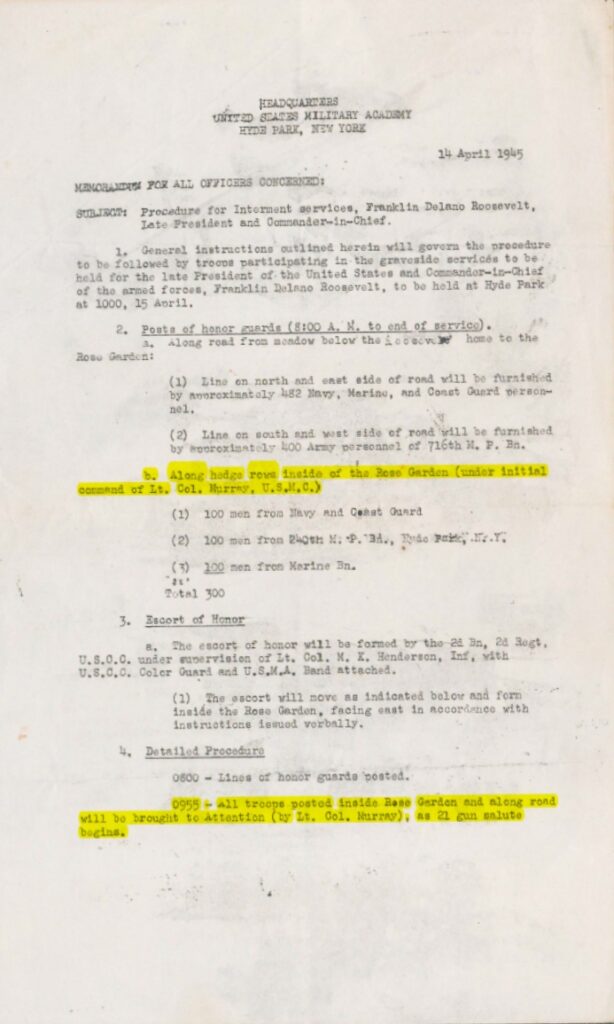
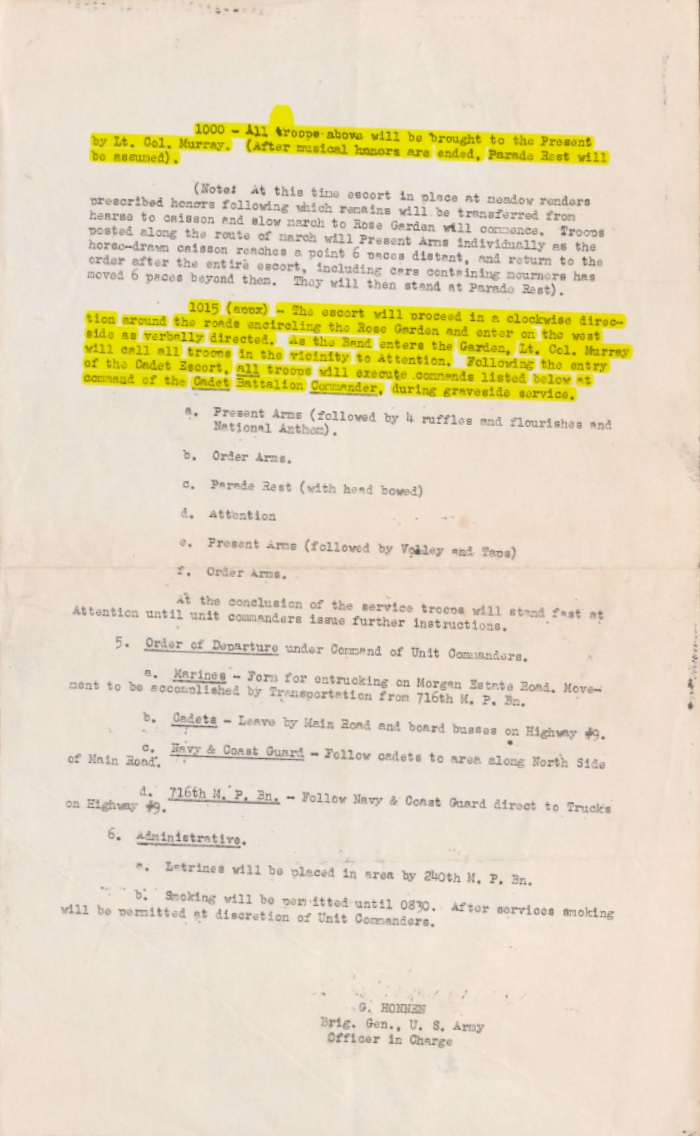
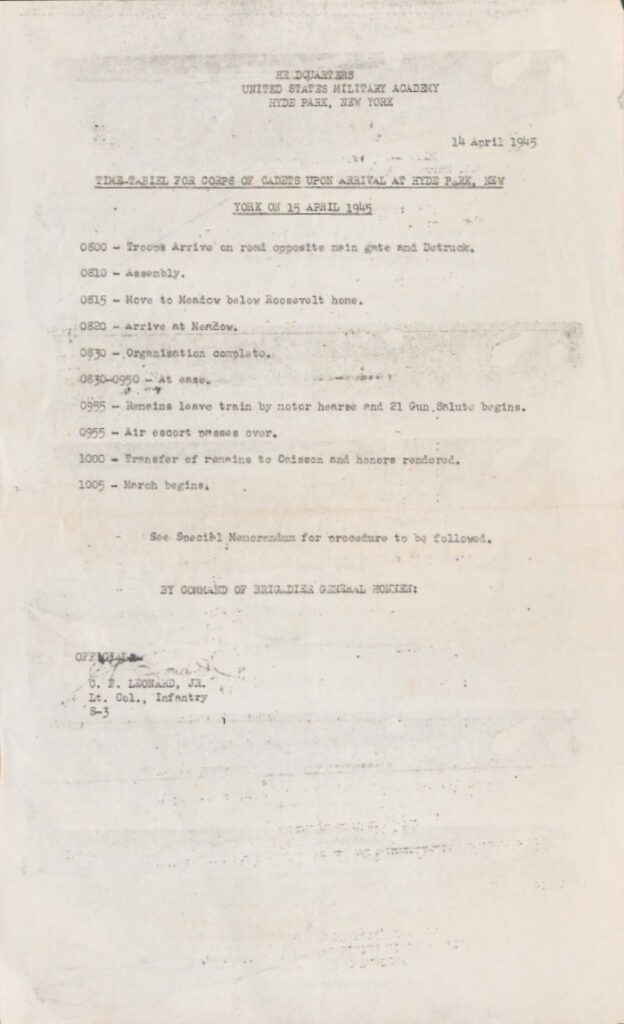
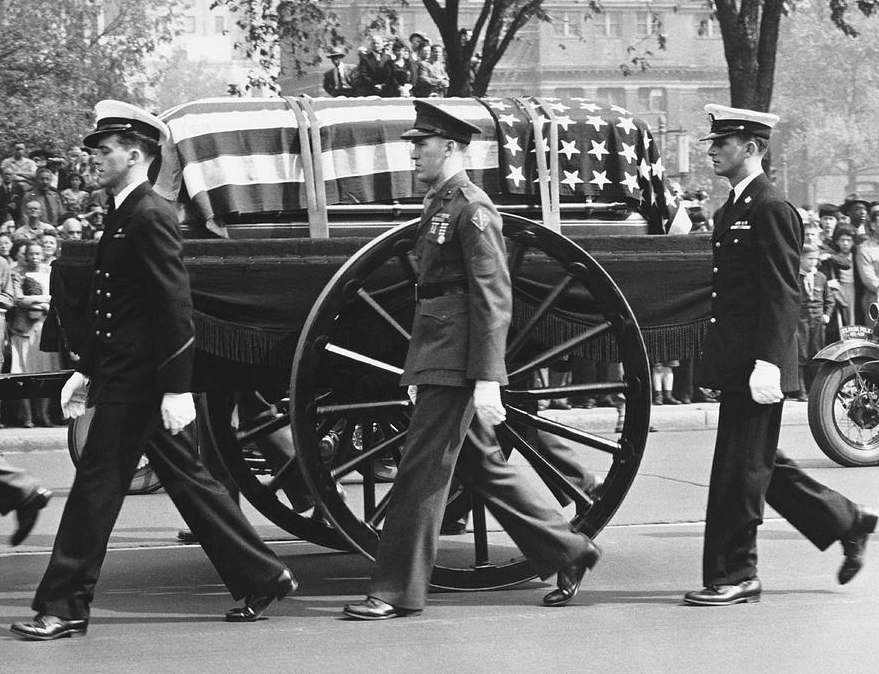
His Award Citations
First Navy Cross
Action Date: June 15, 1944
SPOT AWARD, Fleet Marine Force Pacific: Serial 6067
Citation:
The President of the United States of America takes pleasure in presenting the Navy Cross to Lieutenant Colonel Raymond Leroy Murray (MCSN: 0-5127), United States Marine Corps, for extraordinary heroism as Commanding Officer of the Second Battalion, Sixth Marines, SECOND Marine Division, in action against enemy Japanese forces during the assault on Saipan, Marianas Islands, on 15 June 1944. Although sustaining two severe and painful wounds which necessitated his crawling from place to place during the initial stages of the landing, Lieutenant Colonel Murray refused to be evacuated and continued to direct the operations of his Battalion until his condition became so serious from pain and loss of blood that he was ordered to return aboard ship by the Regimental Commander. By remaining at his post, seriously wounded though he was, during the initial and crucial stages of the assault, Lieutenant Colonel Murray set a fine example for his officers and men and aided materially in overcoming the handicaps resulting from the heavy initial casualties, thereby contributing materially to the success of the operations. His outstanding courage, determination and devotion to duty were in keeping with the highest traditions of the United States Naval Service.
Second Navy Cross
Action Date: December 6 & 7, 1950
Authority: Board of Awards: Serial 1135 (November 19, 1951)
Citation:
The President of the United States of America takes pleasure in presenting a Gold Star in lieu of a Second Award of the Navy Cross to Lieutenant Colonel Raymond Leroy Murray (MCSN: 0-5127), United States Marine Corps, for extraordinary heroism in connection with military operations against an armed enemy of the United Nations while serving as Commanding Officer of the Fifth Marines, FIRST Marine Division (Reinforced), in action against enemy aggressor forces in the Republic of Korea on 6 and 7 December 1950. Charged with the tremendous responsibility of taking over the perimeter defense of Hagaru-ri, and subsequently pressing the attack to Koto-ri in conjunction with another Marine regiment, (the then) Lieutenant Colonel Murray, with his ranks depleted by casualties and all his officers and men exhausted from several days of fierce fighting in sub-zero temperatures, launched vigorous attacks to the eastward to seize a vital enemy-held ridge and consolidate his positions. Affording protection for the airstrip where approximately one thousand vehicles containing division supplies, ammunition and equipment were assembled, he remained until all the wounded had been evacuated. Before directing his regiment in forming a rear guard for the entire column. Throughout the night, he beat of vicious onslaughts continuously launched by the enemy and, on the following morning, carried out a brilliantly executed counterattack, taking two hundred prisoners and leaving an ineffective and decimated enemy in his wake as he continued on to his destination, arriving that evening with units intact and ready to continue the attack to the south. By his great personal valor, daring combat tactics and superb leadership throughout this bitter offensive and defensive action, Lieutenant Colonel Murray served as a constant inspiration to his regiment in completing this extremely hazardous mission against tremendous odds, and his courageous devotion to duty reflects the highest credit upon himself, his gallant officers and men, and the United States Naval Service.
Distinguished Service Cross (Army)
Action Date: November 29 – December 4, 1950
Headquarters, X Corps: General Orders No. 66 (December 15, 1950)
Citation:
The President of the United States of America, under the provisions of the Act of Congress approved July 9, 1918, takes pleasure in presenting the Distinguished Service Cross to Lieutenant Colonel Raymond Leroy Murray (MCSN: 0-5127), United States Marine Corps, for extraordinary heroism in connection with military operations against an armed enemy of the United Nations while Commanding the Fifth Marines, FIRST Marine Division (Reinforced), in action against enemy aggressor forces in Korea from 29 November to 4 December 1950. Charged with the tremendous responsibility of taking over the perimeter defense of Hagaru-ri, and subsequently pressing the attack to Koto-Ri in conjunction with another Marine regiment, (the then) Lieutenant Colonel Murray, with his ranks depleted by casualties and all his officers and men exhausted from several days of fierce fighting in sub-zero temperatures, launched vigorous attacks to the eastward to seize a vital enemy-held ridge and consolidate his positions. Affording protection for the airstrip where approximately one thousand vehicles containing division supplies, ammunition and equipment were assembled, he remained until all the wounded had been evacuated before directing his regiment in forming a rear guard for the entire column. Throughout the night, he beat of vicious onslaughts continuously launched by the enemy and, on the following morning, carried out a brilliantly executed counterattack, taking two hundred prisoners and leaving an ineffective and decimated enemy in his wake as he continued on to his destination, arriving that evening with units intact and ready to continue the attack to the south which contributed materially to the successful breakthrough of United Nations Forces in the Chosin Reservoir area and are in keeping with the highest traditions of the military service.
First Silver Star
Action Date: January 26, 1943
Citation:
The President of the United States of America takes pleasure in presenting the Silver Star to Major Raymond Leroy Murray (MCSN: 0-5127), United States Marine Corps, for conspicuous gallantry and intrepidity as Commanding Officer of the Second Battalion, Sixth Marines (Reinforced), in action against enemy Japanese forces on Guadalcanal Island, Solomon Islands, 26 January 1943. When his battalion, maneuvering into a position in the vicinity of the Pha River and the Coast Road, suddenly encountered withering fire from an enemy strong point, Major Murray, with inspiring leadership and utter disregard for his own personal safety, directed the hazardous advance of his troops to their post and committed them to action. During the remainder of the day and night he was constantly in the most exposed front lines, despite hostile fire from the trees and concealed foxholes, and, through his splendid courage and excellent tactical skill, his command was responsible for the complete destruction or forced retreat of the enemy. Major Murray’s heroic conduct and valiant devotion to duty contributed greatly to the success of this vital mission and were in keeping with the highest traditions of the United States Naval Service.
Second Silver Star
Action Date: November 24 – 28, 1943
Commander in Chief, Pacific: Serial 0647
Citation:
The President of the United States of America takes pleasure in presenting a Gold Star in lieu of a Second Award of the Silver Star to Lieutenant Colonel Raymond Leroy Murray (MCSN: 0-5127), United States Marine Corps, for conspicuous gallantry and intrepidity as Commanding Officer of the Second Battalion, Sixth Marines, SECOND Marine Division, during action against enemy Japanese forces at Tarawa Atoll, Gilbert Islands, from 24 to 28 November 1943. Landing his battalion on a separate island to prevent the enemy from escaping from the eastern end of Betio, then under attack by our forces, Lieutenant Colonel Murray fearlessly countered strong hostile resistance when the island was later secured to lead his men in determined attacks against the fanatic Japanese, forcing them to fall back from one island to another until they were destroyed, and the Atoll seized and occupied. By his forceful leadership, his valiant fighting spirit and dauntless courage under fire, Lieutenant Colonel Murray served as an inspiration to his command during the fierce hostilities and contributed materially to the success of our sustained drive against the Japanese in the Pacific War Area. His unwavering devotion to duty throughout was in keeping with the highest traditions of the United States Naval Service.
Third Silver Star
Action Date: September 15, 1950
Headquarters, Far East Command, General Orders No. 50 (October 27, 1950)
Citation:
The President of the United States of America, authorized by Act of Congress July 9, 1918, takes pleasure in presenting a Bronze Oak Leaf Cluster in addition to a previously awarded Gold Star in lieu of a Third Award of the Silver Star (Army Award) to Lieutenant Colonel Raymond Leroy Murray (MCSN: 0-5127), United States Marine Corps, for conspicuous gallantry and intrepidity while commanding the Fifth Marines, FIRST Marine Division (Reinforced), in action against enemy aggressor forces in the amphibious landing resulting in the capture of Inchon, Korea, on 15 September 1950 in the Inchon-Seoul operation. His actions contributed materially to the success of this operation and were in keeping with the highest traditions of the military service.
Fourth Silver Star
Action Date: August 3 – September 6, 1950
Headquarters, Far East Command, General Orders No. 89 (December 26, 1950)
Citation:
The President of the United States of America, authorized by Act of Congress July 9, 1918, takes pleasure in presenting a Second Bronze Oak Leaf Cluster in addition to a previously awarded Gold Star in lieu of a Fourth Award of the Silver Star (Army Award) to Lieutenant Colonel Raymond Leroy Murray (MCSN: 0-5127), United States Marine Corps, for conspicuous gallantry and intrepidity in action against an armed enemy of the United Nations in Korea during the period 3 August to 6 September 1950. While serving as Commanding Officer of the Fifth Marine Regiment, FIRST Marine Division (Reinforced), Colonel Murray displayed exceptional ability in directing the operations of his regiment against organized enemy resistance of superior strength. With complete disregard for his own safety, Colonel Murray made numerous visits to forward elements of his assault battalions to obtain first-hand information necessary for sound tactical judgment in the employment of his regiment. On 11 August, as the regiment was advancing along the road to Sachon, it was halted by heavy enemy fire directed from well concealed emplacements on high ground overlooking the route of movement. Moving up to the front, constantly exposed to enemy small arms fire, Colonel Murray personally directed the tactical employment of his troops until the situation became stabilized. His cool and positive control of the command, fearless determination, and indomitable courage were an inspirational propellant for his valiantly fighting men and furthered the United Nations campaign for peace. Colonel Murray, through his valor and notable proficiency as a combat commander, reflects great credit on himself and the military service.

He was reinterred with Full Military Honors on Feb. 4, 1949 in Westlawn Cemetery, Norridge, Cook County, Illinois.
PFC Joseph William Zutz (1924-1944 MOS 675-Messenger)
While on Tarawa during WWII, PFC Joseph William Zutz, saved the life of the future Major General Raymond Leroy Murray. In “Highpockets The Man. The Marine. The Legend. An Autobiography of Major General Raymond Murray”, he writes about PFC Zutz. The following is taken verbatim from his book. “I hear my orderly, Zutz scream ‘Colonel! Watch out he has a knife.’ As a Japanese came from nowhere, with a knife aimed at the center of my back, my little orderly hit him with all his weight and pushed him off center, he missed his target. The knife cut through the fleshy part of my upper left arm. With my good arm I hit him and we grappled in the dirt until I could reach my 45 and let him have it with the butt, knocking him out cold and turned him over as a prisoner. The good nuns patched me up and we went on with the war. Thanks to Zutz, I was still in command.”9
On Saipan, he goes on to write: ‘Then mortar became very heavy and I needed to locate a place for my CP (Command Post). I peered over a berm of sand, trying to locate a site, when a mortar shell landed right behind me, killing two lieutenants who were crouched next to me, and wounding fourteen other marines who were in the vicinity. I was knocked out for a few minutes. When I came to, my clothes were in tatters and blood was everywhere. I’m thinking, I must be dead, “Well this is it, this is what it means to be killed in war.” My little orderly is scared to death and can’t get the morphine needle in my arm, and no wonder. By this time I’m getting a little dramatic, telling him, “Well Zutz, I guess I don’t have much longer.” Then I began to feel better and said, “Oh God, I’m not going to die after all. Come on Zutz, let’s run across the road.” It seemed we had plenty of cover. I got it again; a bullet ricocheted and hit me in the hip. We got to the other side and Zutz saw a corpsman and called him over. I asked him “how bad is it?” He said, “Oh God, Colonel, it looks bad.” Again I thought, ‘Jesus, maybe I’ve had the course.” Zutz went for help across the road. He didn’t come back. Worried, I managed to crawl across the road. I saw Zutz’s body there. Another mortar shell had landed and caught him. He had been decapitated. This brave little orderly, who had knocked the Japanese off my back at Tarawa, had lost his life helping me at Saipan. There is no way to tell the emotional toll of losing someone who has been serving this close for so long. He was always just two steps behind me, ready with anything I needed. War is hell.10
MG Murray recounts the story, a little differently, in his ORAL HISTORY TRANSCRIPT located at https://www.usmcu.edu/Portals/218/Murray%2C%20Raymond%20L.pdf on pages 157-159.
It is unknown if the family of PFC Joseph William Zutz knows anything about this story, but I find it hard to believe that Lt. Col. Murray would not have written to his family.
More to Come
Footnotes:
- According to the Alhambra City Directory, the Family lived at 617 South Raymond Avenue in 1926, but the following year they were living at 1200 South Raymond Avenue. Information courtesy of the Alhambra Historical Society. Alhambra High School yearbooks at the time only had pictures of the graduating seniors.
- His diploma from Texas A&M is dated May 31, 1935. His DD214 shows that he entered the military four months earlier on Jan. 3, 1935. His DD214 also states that he had 6 months and 6 days of prior service, which was his Army reserve commission.
- He was planning to be a school teacher, but it was the depression and a military salary of $125/month for 12 months per year was a lot better than a teacher’s salary of $90/month for 9 months per year.
- The Basic School of the United States Marine Corps, is a 28-week course for newly commissioned or appointed officers (warrant officers), focusing on professional knowledge, leadership, and military skills.
- On April 9, 1940, Germany overran Denmark, Iceland’s mother country, whose king was the Icelandic head of state. Roosevelt and Churchill feared that Germany would attack Iceland and would then be able to put more pressure on Scotland and on the merchant shipping in the North Atlantic. By stationing Americans in Iceland, a German attack would automatically bring America into WWII. On June 17, 1944, Iceland declared itself a republic, and while continuing to cooperate with the allies, they remained officially neutral throughout the war. In Iceland, Captain Murray served with (at the time) Major Oliver P. Smith, who was commanding the 1st Battalion, 6th Marines.
- On Tarawa, the marines received assistance, not only from the native islanders but also from a Catholic priest and some nuns in full habits.
- His orderly/aide, PFC Joseph William Zutz, had saved Murray’s life on Tarawa. There is more of his story at the bottom of this page.
- The Marine Corps Mameluke Sword commemorates their actions in the First Barbary War (1801–1805), also known as the Tripolitan War or the Barbary Coast War. Marine Corps Commandant Archibald Henderson (1783 – 1859) adopted the Mameluke sword in 1825 for wear by Marine officers. Reference to the war is also found in the Marine Corps Hymn.
- Found on page 36 of his autobiography. On the same page, he elaborates on the nuns and the assistance they were able to render to the marines. I have always wondered about the WWII movie “Heaven Knows, Mr. Allison” with the nun and marine on a Pacific Island. It seems to contain an element of truth.
- Pp. 53-54
